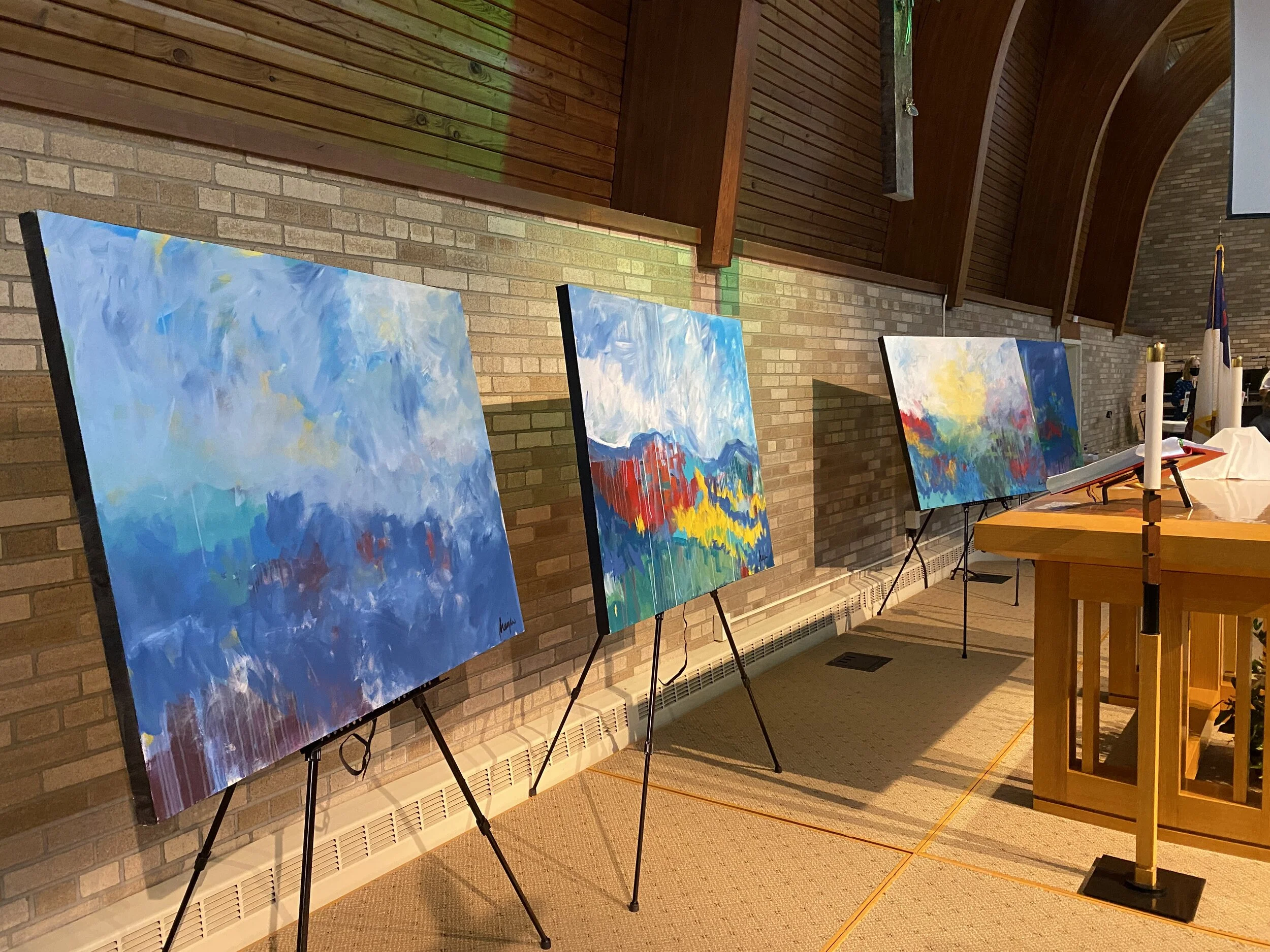Trinity Lutheran Commission
Brainerd, Minnesota 2021
Before I go into the explanation of these four paintings, I want to provide a little art lesson. Many of you probably haven’t taken an art class in many years, maybe a few of you haven’t at all. Either way, there is always an opportunity to learn, or relearn, a little bit about visual language.
I am an abstract painter, where I use color, line/gesture, and shape to tell a story of emotion and ideas. Many folks don’t “get it” and want to find an answer in order to feel more comfortable, but I often have to ask them to step back and just look at the work and look for what I just said -- look for the elements of art first, then the principles… then you will find meaning.
So what are the elements of art? Simple things like line, shape, color, and form. It’s really what you “do” on the surface (in this case, canvas) with what (in this case, paint). A line can be made in a plethora of ways, therefore that is why so many works of art, looking so different, exist in our world.
What are the principles of art? They are what happens as a result of the elements. They are “harmony”, “rhythm”, contrast, movement, emphasis, and variety. You find these same principles in other art forms like music, dance, and film.
There are other things that we consider, and I’ll mention, because I considered them here. In order to create space (an element of art), I needed to think about perspective and vantage point. I had to consider where I was (literally and figuratively) and where you, as the viewer, would be in relation to these pieces. The vantage point is “where you stand” as the viewer in these pieces… and that creates the perspective. While these pieces don’t have a 1 or 2 point perspective like you’d need to draw or paint a city scape or house, they do use atmospheric perspective. To explain that, atmospheric perspective is what makes “purple mountains majesty” that look purple because of how far they are, but you will never land on and walk on a purple mountain… because your eyes see new details the closer you get to an object.
Why do I explain these things? Because I see these concepts in how we see challenges, unrest, humanity, and even God. I read through the comments, words, paragraphs, and drawings and found that the perspectives varied, and changed from person to person. Where one stood, their vantage point, related closely to the clarity of what they experienced, the blessings they saw, and confusion they felt.
Abstract imagery in these paintings are meant to match the abstract emotions you all felt in the past 18 months. Sadness, confusion, isolation, and loss are all abstract terms that if one person says them, the next person feels them differently. Emotion is within the eye of the beholder, just like art. How we manage them, talk about them, believe them, or address them is up to us. Yet, what was so hard about the past year was that some of the key ways to sort out abstract emotions came to be challenging because our rituals of going to church, connecting to community, or even going to the grocery store were uprooted, and there was not a back up plan for many of us.
In these pieces, I pull one hint of symbolism into the work, but try not to do it in an obvious way. I wanted to see God somewhere in each piece, but wanted to change the perspective and atmosphere of each piece. I avoided the cliché rays of light coming out of the dark clouds. Instead, I was inspired by the storm I was standing in (because I’m a storm watcher, after all). When the darkness is there, my body feel the weight of the atmosphere and my eyes hone in on the colors of the sumac, the green of the grasses, the yellow of the blooming weeds, and the glistening of the rocks or pavement. This vibrancy is the detail of what we are gifted with every storm. And we may get the same type of heightened sensation with a fog filled morning, or a post-winter storm day. That is God: the storm and the vibrancy, in the same moment.
Art is about observation. The four canvases allowed me to address the negative and positive expressions that came from your words. Your words informed how I laid down the color, letting it drip and mix up into something confusing or clear. I hope they have a timeless presence in your community space that becomes relatable in the beautifully challenging days ahead. I hope that they provide a different perspective of the hard times, whether it be a pandemic, or a bad day. It was a pleasure to do these pieces, as a document of the collective perspectives of an unprecedented year.
-Heidi Jeub, Speech given at the dedication, October 3, 2021




